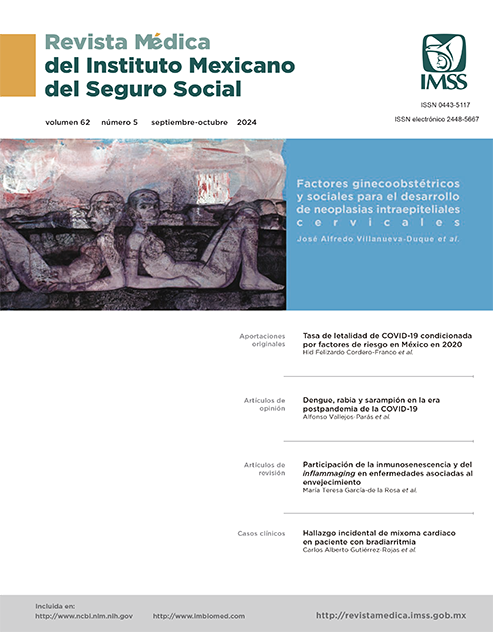Obstetric-gynecological and social factors for the development of cervical intraepithelial neoplasia
Main Article Content
Keywords
Abstract
Background: Cervical intraepithelial neoplasia (CIN) precedes cervical cancer and it is associated with risk factors that can be identified in the population, which contribute to timely diagnosis and treatment.
Objective: To identify associated risk factors for the development of CIN in women attended at the first level of care.
Material and methods: A cross-sectional and retrospective study was conducted in women in the 2020-2022 period. Frequencies and means were obtained. For the differences, chi-squared and Student’s t were used. Odds ratios (OR) were obtained to assess the risk.
Results: ORs were determined in the group of women with CIN II/CIN III, obtaining risks of almost twice the risk factors analyzed compared to the CIN I group, which had the same factors. When analyzed by age groups < or > 40 years, significant associations were determined in the factors of parity, first cytology in life and positive for smoking. In the group < 40 years and with CIN II/III significant risks were determined in age at first pregnancy < 18 (OR 8.33), first cytology in life (OR 3.77), positive for smoking (OR 3.0), sexual intercourse initiation (SII) before 18 years of age (OR 3.1) and parity (OR 1.3).
Conclusions: According to the results obtained, sexual and reproductive behavioral factors are of high risk for the development of CIN.
References
International Agency for Research on Cancer. The Global Cancer Observatory. [sin lugar de publicación]: IARC; 2024. Disponible en: https://gco.iarc.who.int/media/globocan/factsheets/populations/484-mexico-fact-sheet.pdf.
Instituto Mexicano del Seguro Social. Base de datos del Registro Institucional de Cáncer de la Unidad de Medicina Familiar No. 15 del periodo 2020-2022. México: IMSS; 2020-2022.
Heredia-Caballero AG, Palacios-López GG, Castillo-Hernández MC. Prevalencia y tipificación de genotipos de virus del papiloma humano en mujeres del área metropolitana del Valle de México. Ginecol Obstet Mex. 2017;85(12):809-18. doi: 10.24245/gom.v85i12.1537.
Campos-Romero A, Anderson K, Longatto-Filho A, et al. The burden of 14 hr-HPV genotypes in women attending routine cervical cancer screening in 20 states of Mexico: a cross-sectional study. Scientific Reports, 2019;9:10094. doi: 10.1038/s41598-019-46543-8.
Soto-Fuenzalida GA, Hernández-Hernández JA, López-Sánchez RC, et al. Tipificación de serotipos del virus del papiloma humano de alto riesgo. Ginecol Obstet Mex. 2020; 88 (10): 659-66. doi: 10.24245/gom. v88i10.3432.
Gutierrez Campos R, Malacara Rosas A, Gutierrez Santillan E, et al. Unusual prevalence of high-risk genotypes of human papillomavirus in a group of women with neoplastic lesions and cervical cancer from Central Mexico. PLoS ONE 2019;14(4):e0215222. doi: 10.1371/journal.pone.0215222.
Adcock R, Cuzick J, Hunt W. et al. Role of HPV Genotype, Multiple Infections, and Viral Load on the Risk of High-Grade Cervical Neoplasia. Cancer Epidemiol Biomarkers Prev. 2019;28(11):1816-1824. doi: 10.1158/1055-9965.
Molina-Pineda A, López-Cardona MG, Limón-Toledo LP. High frequency of HPV genotypes 59, 66, 52, 51, 39 and 56 in women from Western Mexico. BMC Infect Dis. 2020;20(1):889. doi: 10.1186/s12879-020-05627-x.
Huang J, Deng Y, Boakye D. et al. Global distribution, risk factors, and recent trends for cervical cancer: A worldwide country-level analysis. Gynecol Oncol. 2022;164(1):85-92. doi: 10.1016/j.ygyno.2021.11.005.
Olubodun T, Balogun M R, Olowoselu OI. Et al. Cervical Cancer Knowledge, Risk Factors and Screening Practices among Women Residing in Urban Slums of Lagos, Southwest, Nigeria. West Afr J Med. 2022;39(6):595-602.
Mohammed H Al-Azri , Maytha Al-Saidi. Et al. Knowledge of Risk Factors, Symptoms and Barriers to Seeking Medical Help for Cervical Cancer among Omani Women Attending Sultan Qaboos University Hospital. Sultan Qaboos Univ Med J. 2020;20(3):e301-9. doi: 10.18295/squmj.2020.20.03.009.
Hernández-Rosas F, Orozco-Hernández E, Maza-Sánchez L. Prevalence and correlation of human papillomavirus genotypes with clinical factors in cervical samples from Mexican women. Exp Biol Med (Maywood). 2021;246(1):48-56. doi: 10.1177/1535370220959747.
Kalliala I, Athanasiou A, Veroniki AA, et al. Incidence and mortality from cervical cancer and other malignancies after treatment of cervical intraepithelial neoplasia: a systematic review and meta-analysis of the literature. Ann Oncol. 2020;31(2):213-27. doi: 10.1016/j.annonc.2019.11.004.
Ledesma-López V, López-Casamichana M, Fragozo-Sandoval F, et al. Perfil epidemiológico y algunas determinantes sociales de mujeres mexicanas con lesiones intraepiteliales cervicales en el Hospital Juárez de México y la Clínica Integral de la Mujer. Revista del Hospital Juárez de México. 2017;84(2):70-6.
Min KJ, Lee JK, So KA, et al. Association Between Passive Smoking and the Risk of Cervical Intraepithelial Neoplasia 1 in Korean Women. J Epidemiol. 2018;28(1):48-53. doi: 10.2188/jea.JE20160118
Sánchez-Ledesma R, Fernández-Martínez LC, Rodríguez-Gómez MR et al. Factores de riesgo del cáncer cérvico- uterino en San Juan y Martínez. Rev Ciencias Médicas, 2021;25(6):e5287.
Seefoó-Jarquín P, Sosa-Jurado F, Maycotte-González P. Panorama epidemiológico de las displasias cervicales en una unidad de primer nivel de atención. Rev Med Inst Mex Seguro Soc. 2023;61(2):155-62. Disponible en: https://www.ncbi.nlm.nih.gov/pmc/articles/PMC10395894/pdf/04435117-61-2-155.pdf
Gallegos-Toribio R, Fuentes-Vargas MA, Gonzales-Menéndez MJM. Factores del estilo de vida predisponentes a displasia cervical en mujeres atendidas en el Hospital María Auxiliadora. Rev Fac Med Hum. 2019;19(2):48-56. doi: 10.25176/RFMH.v19.n2.2065
Torreglosa-Hernández S, Grisales-Romero H, Morales-Carmona E, et al. Supervivencia y factores asociados en pacientes con cáncer cervicouterino atendidas por el Seguro Popular en México. Salud Publica Mex. 2022;64:76-86. doi: 10.21149/131.8
Mendoza KG, Cunningham KW. Factores de riesgos en mujeres diagnosticadas con lesiones pre-malignas de cáncer cérvicouterino. Revista Universitaria Del Caribe. 2019;21(2):71-83. doi: 10.5377/ruc.v21i2.776
Bowden SJ, Doulgeraki T, Bouras E. Risk factors for human papillomavirus infection, cervical intraepithelial neoplasia and cervical cancer: an umbrella review and follow-up Mendelian randomisation studies. BMC Medicine. 2023;21:274. doi: 10.1186/s12916-023-02965-w
Torres-Poveda K, Ruiz-Fraga I, Madrid-Marina V, et al. High risk HPV infection prevalence and associated cofactors: a population- based study in female ISSSTE beneficiaries attending the HPV screening and early detection of cervical cancer program. BMC Cancer. 2019;12:1250. doi: 10.1186/s12885-019-6388-4
Luciani S, Bruni L, Agurto I, et al. HPV vaccine implementation and monitoring in Latin America. Salud Publica Mex. 2018;60(6):683-92. doi: 10.21149/9090
Frietze G, Oliva R, Shenberger-Trujillo JM. Human Papillomavirus (HPV) Vaccine acceptability in Hispanic males living on the U.S./Mexico border. Hisp Health Care Int. 2021;19(1):55:56. doi: 10.1177/1540415320921479


